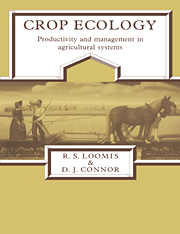Part I - Farming systems and their biological components
Published online by Cambridge University Press: 05 June 2012
Summary
A view from space gives emphasis to areal dimensions of vegetation and agriculture at the thin interface between atmosphere and solid earth. It is only by spreading plants across the landscape that they efficiently intercept fluxes of limiting resources such as CO2, water, and sunlight. Tillage, rates of crop growth, and accumulation of yield all relate to the areas of land involved. In farming, land is divided into individual fields as the units of management and production. In ecological terms, the plants that occupy those fields constitute a community of cohabiting organisms. A community considered together with the chemical and physical features of the environment form a further fundamental grouping, the ecosystem.
Farmers' efforts in crop and pasture management aim at beneficial control over the structure of crop communities and physical and chemical aspects of the environment. Establishment of plant communities dominated by desirable species is presented in Chapter 1 as the basic strategy of agriculture.
This is followed by discussions of community structure (Chapter 2), stability (Chapter 3), genetic resources (Chapter 4), and plant development (Chapter 5). All are important topics relating to the biological materials used in agriculture.
- Type
- Chapter
- Information
- Crop EcologyProductivity and Management in Agricultural Systems, pp. 1 - 2Publisher: Cambridge University PressPrint publication year: 1992
- 1
- Cited by



